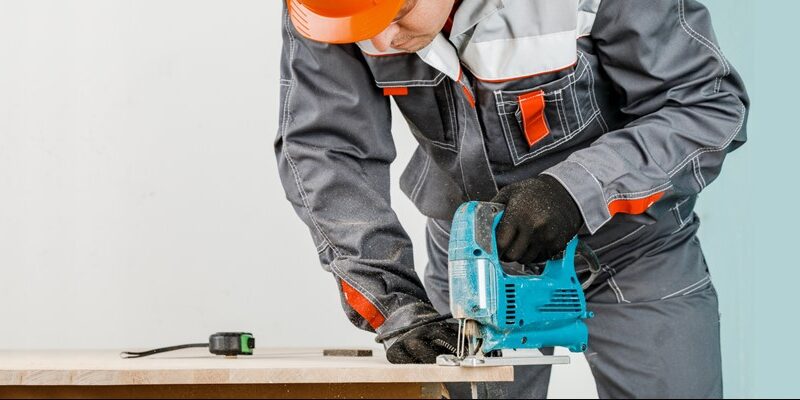When you cut, the blade is very important. A new blade will help you to cut more easily and quickly. Changing your blade can be quick and easy.
Usually, you will see that your cuts are faster and more accurate after changing the blade on your saw. This is because a new, sharp blade will cut through the material faster and with greater accuracy. But you need to make sure which type of blade it is. For example, thin-kerf blades are good for cutting through metal or hardwood. A thicker-kerf blade might be better for softer materials like wood if you’re cross-cutting it.
A new blade will also produce less noise and vibration, as well as result in a better cut finish. Changing your saw blade is important because it can make the blade sharper. The only thing you need to do before changing your saw blade is make sure it has been mounted on the arbour of your machine that holds it in place. You should also ensure that both ends of your blade are free from chips or damage before moving forward. You can visit fridayrack.com/how-to-change-jigsaw-blade/ to buy your suitable saw blades.
When changing your saw blade, you should also take into account the type of material you will be cutting.
There are different types of blades for different purposes. For example, there are blades that are good for cutting through stone or brick. There are also blades that cut across the wood. You should choose the right size blade for your saw, depending on what you want to cut. If you use a blade that is too small, it will be hard to cut through thick materials because it might not have enough power. If you use a blade that is too large, it might be hard on your machine and cause damage quickly.
Once you have chosen the right blade for the job, how active should your saw become? A sharp blade cut through material quicker and more easily. If you have a dull or blunt blade, it will not cut as well. But if you have a few different blades to choose from, try them out before picking one.
CHANGES IN ROUTINE:
It is the first time you use the saw. You need to make some changes when cutting with a new blade. If you usually make many small cuts to remove material, don’t do it when using a new blade. Make one long cut instead for this blade. Your blades come sharpened, but they might need more work after that before it is perfect and can give its best performance. To have your blades ready for use, get them professionally sharpened before using them.
How to select the best blade for your saw?
Here are some common types:
If you don’t know which blade to use, then take a look at the technical documents from the manufacturer of that blade. Or you could go to the company itself and ask them about it. Know that not all blades are good for all jobs. You should have a combination of blades with different shapes in your toolbox in order to do a lot of different tasks with your saw.
All-purpose blades:
These are typically designed for fast material removal and will have good scoring abilities as well as the ability to cut curves and miters. These blades tend to leave scratches on the surface because they produce more heat than other types of blades do. They also won’t give you much clean-cut accuracy in thinner materials where precision is important.
General-purpose blades –
As their name suggests, these saw blades are great for most applications. They are fast cutting and give a good finish with minimal chipping or tearing of the material.
Finishing blades –
These types of blades cut smoother than the general-purpose saw blades do and produce little to no burning on the surface, even when working with thin materials. This is because they generate less heat during the material removal process. You can use them for both roughing and finishing applications without having to make any changes to your procedure.
Woodworking/finish blades –
A miter saw is a tool that can cut through wood, plastics, and other materials. It is not safe to have the speed over 3,000 ft/min because this can make the blade lose control and hurt someone.
Steel miter saw blades –
This is a blade that can cut different materials. It cuts plastic, wood, and metals. It removes the material very fast without burning it. This is a good choice for cutting many types of material with a table saw.
Changing blades will improve performance and increase your productivity:
- These blades can make a miter saw work harder, leading to decreased accuracy and more wear on the saw. A sharp blade also makes for a cleaner cut, meaning that you’ll have less clean-up to do after you’re done.
- Dull blades can also heat material more quickly, which can cause it to warp or melt. This is particularly dangerous when working with plastics or other delicate materials.
- A sharp blade will also last longer than a dull one, meaning that you won’t have to replace it as often. This can save you both time and money in the long run.
What kind of material will this blade cut?
The most important factor in selecting a blade is determining what material you’ll be cutting with it. The best cutting blade is one that can cut wood. It has teeth for cutting wood. This blade will not work well on plywood or particleboard.
When you’re cutting metal with a power saw, it’s important to pick the right blade. The blade should have teeth that can cut through metal. If you’re not sure which type of blade to use, then it is best to use one that has more teeth than might be necessary. This will provide greater stability while ensuring smooth cuts without bogging down your saw.
Conclusion:
The point is that changing the blade on your saw can make a big difference. Choosing the right blade and using it correctly from fridayrack.com/ will help you get your job done faster.

